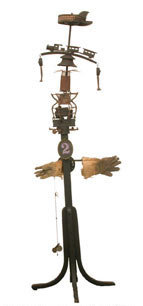Gordon Wagner
dal 16/11/2007 al 29/12/2007
Segnalato da
16/11/2007
Gordon Wagner
Tobey C. Moss Gallery, Los Angeles
The Passion of Assemblage. The exhibition explores works from a major figure in 20th century American assemblage and collage. His works include cast iron toys, railroad spikes, gears, signs, photographs, wood, eviscerated typewriters and other memorabilia.

The Tobey C. Moss Gallery presents The Passion of Assemblage, an installation of 19 works from world-renown California Assemblage artist Gordon Wagner.
Around the same time that artists such as Robert Rauschenberg and John Chamberlain began making art out of trash in 1950s New York, a parallel movement emerged on the West Coast that came to be known as California Assemblage. Like their East Coast counterparts, the California artists created works out of found objects from beaches, junkyards, attics, basements and every day life and transformed them into formal conundrums and pop cultural critiques on society. But in contrast to their East Coast contemporaries, whose works derived primarily from Cubism or Constructivism and had a tendency to revolve around formal concerns, the California Assemblage artists were more concerned with psychological or social meanings with roots based in Surrealism and Symbolism.
Gordon Wagner: The Passion of Assemblage, on view November 17-December 30, 2007, explores works from a major figure in 20th century American assemblage and collage, Gordon Wagner (1915-1987), who is considered the “godfather” of California Assemblage. Wagner created his first assemblage – Seven Actors – in 1952, a year before Robert Rauschenberg created his first “Combines” and several years before Edward Kienholz first exhibited his assemblages at the Ferus Gallery. Wagner was an influence on younger artists, including George Herms, Michael McMillen and Betye Saar, who used to gather in his studio.
Born in Redondo Beach, California, Gordon Wagner received degrees from both Chouinard Art Institute and UCLA. He worked as an engineer-designer in the aerospace industry for over 20 years while studying the Indian myths and legends of Arizona and Mexico during travels to those regions in the late 1940s and early 1950s. Wagner began exploring art though easel painting and drawing with an emphasis on Abstract Expressionism, and while his scientific background was one inspiration for his paintings, the seashore and nearby amusement park environments of Southern California also exerted strong influences upon him. Beachcombing for detritus along the California coast became an important source for his pioneering contributions to the medium of assemblage art.
“The assemblages of Gordon Wagner evoke rugged moods, tinged with noirish nostalgia” (Michael Duncan, Art in America, May 2001). One of his earliest assemblagists, Piece of Pieces from the Sea, that he began in the 1954, pays tribute to his childhood where as a young orphan, he scavenged local dumps and the washed up objects near Redondo and Venice Beaches for treasures including cast iron toys, railroad spikes, gears, signs, photographs, wood, eviscerated typewriters and other memorabilia. The Mexican Night Clerk (1960-65) depicts a mysteriously romantic, seedy locale out of a worn typewriter, a key rack, a skull and a daguerreotype, arranged across a weathered door. The Shrine Box (1961/64) conjures voodoo mojo, with its candles, icons, feathers and valentine. One of his last works, Our Lady of Guadalupe, pays homage to an important figure of Mexican culture.
A catalogue, published by the Tobey C. Moss Gallery and the Pierre Menard Gallery of Cambridge, MA, with introductions by George Herms (noted assemblage artist) and Sophie Dannemueller (art historian at the Pompidou Center in Paris for the "Los Angeles 1955-1985" exhibition), is available. An additional work by Gordon Wagner, entitled Between Heaven and Hell, is currently on display at the Los Angeles County Museum of Art as part of the SoCal: Southern California Art of the 1960s and 70s from LACMA's Collection show that runs through March 2008.
Opening Reception: Saturday, November 17, 12-5pm
Tobey C. Moss Gallery
7321 Beverly Blvd. - Los Angeles
Hours, Tuesday - Saturday, 11am-5pm
Free admission



